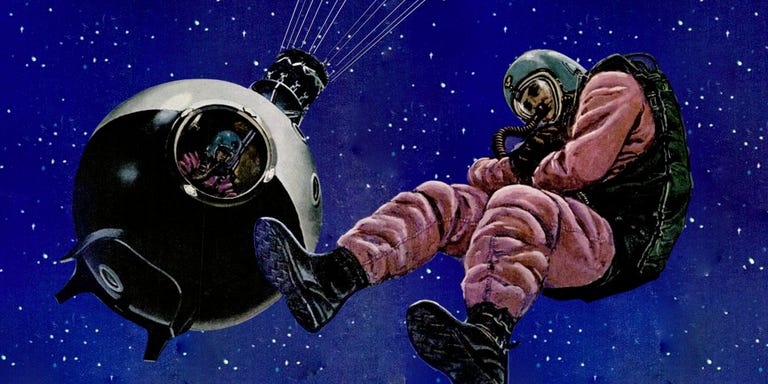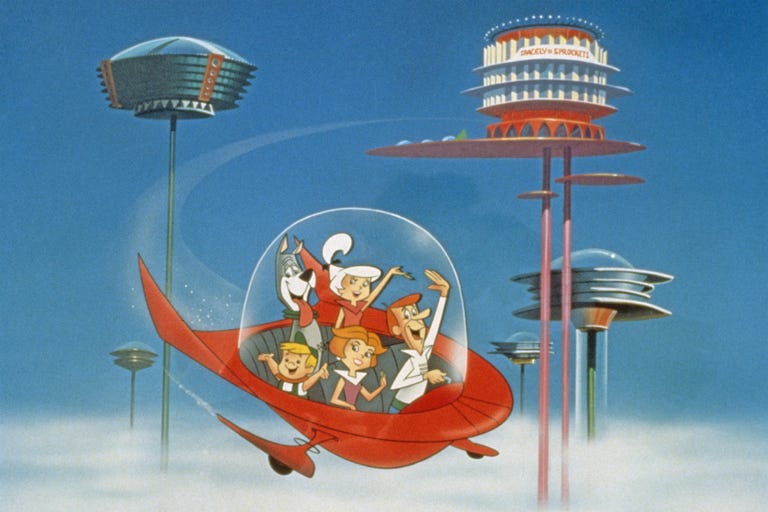4 Mega Projects That Could Save Humanity
Humanity’s facing some really big problems, and they’ll need some really big answers.

POPULAR MECHANICS / MICHAEL STILLWELL
By Joe Pappalardo
Humans have some big problems, like wipe-us-out-as-a-species kind of problems. Luckily, we put our brains and thumbs to good use. Over the years there has been no shortage of serious researchers who have spent time on thought experiments about ways to thwart Armageddon—self-inflicted or otherwise.
So maybe with these four ideas, we might prove that Earth’s biped toolmakers have what it takes to endure the cataclysms to come.
Steering World-Killing Asteroids
live in a scary universe where errant space rocks can—and have—wrought destruction on a planetary scale. We get hit all the time, and it’s just a matter of time until a big enough world-killer sails into view of our space telescopes. The plan, as anyone who’s seen Armageddon knows, is to nuke the hell out of it. The point is not to blow it into still-dangerous fragments, but to knock the rock off its destructive course.
As satisfying as that plan sounds, there’s a lot we don’t know about nuking space rocks. Not all asteroids are composed of the same thing, muddling models of the effects of a detonation. some say better deflection is caused with a surface detonation, others advise to detonate at a distance to zap more surface area and cause more movement.
But there’s a third option, one that advocates for space tractors that can tow the asteroid off course. Slowly and steadily, a small spacecraft powered with a solar sail could nudge an asteroid 15 million times its size out of the path of Earth. That’s the tentative conclusion of a pair of Finnish researchers in a paper published in 2010. They studied how an improved solar sail called an “E sail,” which uses charged tethers to extract momentum from the solar wind particles to gain improved propulsive thrust, could save the world.
For all its size, the solar sail is a pretty lightweight payload, so a heavy launch vehicle could hoist the vehicle into orbit and send it on its way. After its long trip, the craft faces down the asteroid armed with harpoon tow cables. If the asteroid is not solid enough to be harpooned, there is always the option of capturing the cosmic dust ball with a big net.
The distance between the sail and the asteroid would have to be carefully maintained, and that means the spacecraft would need to be smart and equipped with thrusters to perform this stationkeeping. The researchers say that even “a modest E Sail system” could move a big asteroid by two Earth radii in ten years.
Of course you could always combine a little from both methods. Researcher from the University of Arizona and a counterpart from Russian Academy of Sciences proposed a solar sail system to get the tow spacecraft into position, but then uses aluminized Mylar in those sails to focus a beam of sunlight into the space rock. This would heat the surface and create a jet of vaporized material, which creates the motion needed to push the asteroid out of Earth’s way.
Building a Lunar Doomsday Ark
There are some who feel that the Svalbard Global Seed Bank, established on a Norwegian island in 2015 (pictured above) to preserve the world’s most vital crops, is enough protection against planetary calamity. But when it comes to asteroid impacts or a self-inflicted nuclear winter, there needs to be backup for the backup.
About 10 years ago a lunar scientist at the European Space Agency floated an idea for a lunar facility that could house DNA records of Earth’s life forms, embryos, microbes, and seeds. Bernard Foing, the lead scientist for the ESA's SMART-1 lunar mission that ended in 2006, pitched the idea a couple years after his probe intentionally crashed into the surface.
Foing envisioned a fully automated facility that ran and maintained itself for as long as it was needed. Transmitters would beam the DNA sequences to hardened receivers on Earth, where future survivors could use genetic engineering to speed the rebuilding of the ecosystem and civilization.
The Moon has some things going for it when it comes to secure storage. Obviously, being away from Earth is a benefit when it comes to many world-ending scenarios. Storing things in Earth’s orbit is not as secure, with the threat of meteors and the constant fight against Earth’s gravity challenging long-term planning. The Moon also has abundant sunlight and water to help keep the facility running.
And most drawbacks can be designed around, like burrowing the vault under regolith to protect it from meteor bombardment, which is worse on the moon due to its lack of gravity.
Foing now works on Mars programs at ESA, and the lunar doomsday vault idea has stalled. The idea likely needs an impetus, some looming calamity, to adopt the paranoid mindset that makes this costly insurance plan worth the effort.
Controlling the Sun
In 1992 Russia launched a solar mirror called Znamya 2 with a unique mission—to beam reflected light back to the planet, raking western Russia with extra light equivalent to a full moon. The patch of light was 5km wide and traveled across Europe at 8km a second. A second attempt failed in space when the sail snagged on an antenna as the flexible mirror unfurled.
So it’s certainly possible to use solar reflectors to change the amount of solar energy that pours into the Earth, but would you want to? Doesn’t the proposed Geoengineering Research Act in 2016 want to seed clouds with sulfur to make them more reflective, so do we really need more sunlight when global warming is the problem?
Turns out it depends on where you aim. For starters, a nice beam of light could make solar farms more effective and could power large scale clean energy projects like molten salt towers. By inspiring more plant growth with increased sunlight, more carbon—the villain behind our warming planet—could be absorbed.
Sounds good, so let’s go big with it. In 2001 Lowell Wood, of Lawrence Livermore National Laboratory, calculated that deflecting just 1 percent of sunlight would restore climatic stability. Future humans could park massive solar reflectors to help decrease the total amount of sunlight hitting the planet.
It would take about 600,000 square miles or mirrors to do it. Park a fleet of them at the earth-sun Lagrange point, where the gravity between the two celestial bodies makes it easy to keep them in one place and then regulate what comes in and out like cosmic shutters.
Krafft Ehricke, legendary space engineer and contemporary of Werner von Braun in the German and U.S. rocket programs, spent 10 years studying solar light reflection and how it could benefit humanity. His paper, published in the 1979, is a great example of how super smart people approach massive engineering problems.
Creating a Worldhouse in the Sky

GETTY IMAGESWARNER BROS.
The world's population is just north of 7 billion and steadily growing. According to the United Nations, the population could be on track for 11 billion humans by 2100. No one can really be sure what this steady boom in humanity will do to our planet, but even with steady technological advances in conservation and food production, Earth could very well be stressed to the point of ecological collapse.
With only so much room on the surface, maybe Earth needs a second floor.
In 1992 Richard Taylor wrote an often cited Journal of the British Interplanetary Society paper that detailed how humans could construct a “worldhouse.” The way he saw it, terraforming another planet took too much time and investment, so he suggested building massive domes on 3km high towers.
On some distant world, the center tower would be home to 500,000 settlers and the dome would be transparent to harness light for greenhouses and an entire life-giving ecosystem.
But transporting this idea to Earth wouldn’t be a bad idea, especially in a future with a population clustered in mega-cities and where resources are stretched thin. Building worldhouses over deserts, oceans, and the poles could help feed the population, ease the demand on the planetary ecosystem, and give people a place to live close to food and abundant solar power.
Vertical super cities have been on the drawing boards since the 1960s, but the real trick is getting an ecosystem that is self-sustaining. The big problems with life support systems is that they get out of whack, like in 1993 when Biosphere 2’s plants didn’t produce enough oxygen.
Unlike a worldhouse over Mars, the terrestrial versions could do the same. The goal would be to waste little and recycle a lot, which does not require an independent biosphere.



No comments:
Post a Comment